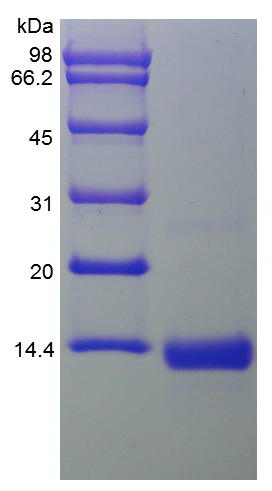- Synonyms
- BMP-2B
- Source
- Escherichia coli
- Molecular Weight
- Approximately 13.3 kDa, a monomeric, non-glycosylated polypeptide chain containing 117 amino acids.
- Size
- 10 μg/100 μg/500 μg
- AA Sequence
- MSPKHHSQRA RKKNKNCRRH SLYVDFSDVG WNDWIVAPPG YQAFYCHGDC PFPLADHLNS TNHAIVQTLV NSVNSSIPKA CCVPTELSAI SMLYLDEYDK VVLKNYQEMV VEGCGCR
- Purity
- > 95% by SDS-PAGE.
- Biological Activity
- Data is not available.
- Physical Appearance
- Sterile Filtered White lyophilized (freeze-dried) powder.
- Formulation
- Lyophilized from a 0.2 µm filtered concentrated solution in 50 mM Na2CO3, 5 mM DTT, 5% Trehalose, 0.02% Tween 20, pH 11.0.
- Endotoxin
- Less than 1 EU/µg of rHuBMP-4 as determined by LAL method.
- Applications
- 1. Molecular standard (Western, ELISA) in studying secreted BMP-4;
2. Preparing antibodies for BMP-4 monomer;
3. Molecule standard in detecting secreted BMP-4 in reduced SDS-PAGE.
- Reconstitution
- Prior to opening, it is recommended to centrifuge the vial briefly to bring the contents down the bottom. Reconstitute in sterile distilled water to a concentration of 0.1-1.0 mg/mL. If animal-origin-free condition is expected in your product, then sterile distilled water is recommended. Stock solutions should be apportioned into working aliquots and stored at ≤ -20 °C. Further dilutions should be made in appropriate buffered solutions.
- Shipping
- The product is shipped with polar packs. Upon receipt, store it immediately at the temperature recommended below.
- Stability & Storage
- Use a manual defrost freezer and avoid repeated freeze-thaw cycles.
- A minimum of 12 months from date of receipt, when stored at ≤ -20 °C as supplied.
- 1 month, 2 to 8 °C under sterile conditions after reconstitution.
- 3 months, -20 to -70 °C under sterile conditions after reconstitution.
- Usage
- This material is offered by Shanghai PrimeGene Bio-Tech for research, laboratory, or further evaluation purposes. NOT FOR HUMAN USE.
- SDS-PAGE

- Reference
- 1. Yamashita H, Murayama C, Takasugi R, et al. 2011. Mol Cell Biochem, 348: 183-90.
2. Yates KE, Troulis MJ, Kaban LB, et al. 2002. Int J Oral Maxillofac Surg, 31: 173-8.
3. Bessa PC, Cerqueira MT, Rada T, et al. 2009. Protein Expr Purif, 63: 89-94.
4. Kawakami T, Kumasaka M, Kato M, et al. 2011. J Dermatol Sci, 63: 66-9.
- Background
- Bone Morphogenetic Protein 4 is one of the BMPs, some of which belong to the TGF-beta superfamily (BMP2-7). There are more than thirteen BMPs have been discovered nowadays and they are involved in inducing cartilage and bone formation. BMP-4 is expressed in the lung and lower levels seen in the kidney. It also presents in normal and neoplastic prostate tissues, and prostate cancer cell lines. It regulates the formation of teeth, limbs and bone from mesoderm. Furthermore it also plays a role in fracture repair. BMP-4 signals through tetrameric complexes composed of type I and type II receptors and regulates it function by interaction with multiple proteins and glycosaminoglycans. The human BMP-4 shares 98 % sequence indentity with mouse BMP-4. Reduced expression of BMP-4 is associated with a number of bone diseases, including the heritable disorder Fibrodysplasia Ossificans Progressiva.










 COA Application
COA Application


